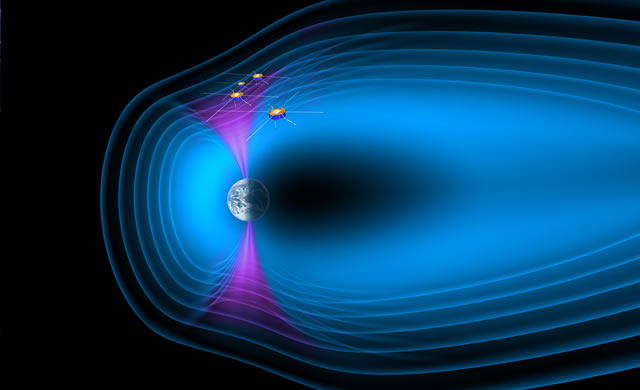
Credit: ESA/AOES Medialab
Magnetosfera “colabrodo”
Uno studio sui dati provenienti da Cluster mostra come il vento solare possa attraversare la regione più esterna dello scudo magnetico che protegge la Terra. L’allineamento del campo magnetico interplanetario e di quello terrestre aprirebbe le porte al plasma.
Quattro satelliti della sonda Cluster dell’ESA hanno rilevato come lo scudo della magnetosfera terrestre potrebbe essere meno protettivo di quanto si pensasse. Gli scienziati del Goddard Space Flight Center della NASA in Maryland hanno osservato, per la prima volta in modo diretto, la presenza di alcune onde del vento solare, chiamate Kelvin-Helmholtz, che potrebbero permettere il trasferimento di energia nella magnetopausa, la regione esterna dello scudo magnetico intorno al nostro pianeta. Il risultato a cui sono giunti è che questa particolare regione si starebbe comportando non tanto come una barriera continua quanto piuttosto come un filtro, un setaccio, lasciando aperto qualche varco all’assalto continuo di elettroni e protoni energetici. Ciò accade a seconda del modo in cui il campo magnetico interplanetario del vento solare – comunemente chiamato IMF – è allineato con il campo magnetico della Terra, dando vita a diversi fenomeni che possono sorgere nelle vicinanze della Terra.
Fonte/Leggi tutto → Media.Inaf.it
NASA Study Using Cluster Reveals New Insights Into Solar Wind
A new study based on data from European Space Agency’s Cluster mission shows that it is easier for the solar wind to penetrate Earth’s magnetic environment, the magnetosphere, than had previously been thought. Scientists from NASA’s Goddard Space Flight Center in Greenbelt, Md. have, for the first time, directly observed the presence of certain waves in the solar wind—called Kelvin-Helmholtz waves that can help transfer energy into near-Earth space—under circumstances when previous theories predicted they were not expected. The recent paper, published on Aug 29, 2012, in the Journal of Geophysical Research shows that the presence of these waves help the incoming charged particles of the solar wind breach the magnetopause—the outer region of the magnetic “shield” our planet.
As a result, the boundary of Earth’s magnetic bubble behaves less like a continuous barrier and more like a sieve allowing entry to the continuous onslaught of energetic electrons and protons. “The complex environment near Earth varies continuously, but it is always filled with strong and complex magnetic fields. Variations in the pressure of the solar wind and in the orientation of the magnetic field can lead to changes in how the magnetosphere responds to the solar wind,” says Melvyn Goldstein, a geospace scientist at Goddard and an author on the paper. “And understanding how the solar wind impacts these changes by transferring material, momentum and energy across the magnetopause, is one of the most important questions in magnetospheric physics in general and space weather effects in particular.”
Source/Continue reading → NASA.gov





















